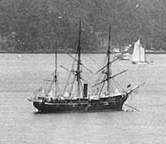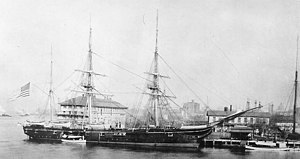
The first USS Newark (C-1) was a United States Navy protected cruiser, the eighth protected cruiser launched by the United States. In design, she succeeded the "ABC" cruisers Atlanta, Boston, and Chicago with better protection, higher speed, and a uniform 6-inch gun armament. Four additional protected cruisers were launched for the USN prior to Newark.

USS Dolphin (PG-24) was a gunboat/dispatch vessel; the fourth ship of the United States Navy to share the name. Dolphin's keel was laid down by Delaware River Iron Ship Building and Engine Works of Chester, Pennsylvania. She was launched on 12 April 1884, with Captain George Dewey in command, and commissioned on 8 December 1885 with Captain R. W. Meade in command. Dolphin was the first Navy ship to fly the Flag of the President of the United States during President Chester A. Arthur's administration, and the second Navy ship to serve as a presidential yacht.

USS John King (DD-953/DDG-3) was a Charles F. Adams-class guided missile armed destroyer in the United States Navy named for Medal of Honor recipient John King.

USS Raleigh (C-8) was a United States Navy protected cruiser of the Cincinnati class, commissioned in 1894 and in periodic service until 1919.

USS Dyess (DD/DDR-880), a Gearing-class destroyer, was a ship of the United States Navy named for Aquilla James Dyess (1909–1944). Dyess was awarded the Medal of Honor posthumously for his leadership of his battalion of Marines in the Battle of Kwajalein. The ship was laid down by Consolidated Steel Corporation at Orange, Texas on 17 August 1944, launched on 26 January 1945 and commissioned on 21 May 1945. The vessel spent the majority of her career patrolling the Mediterranean Sea with NATO forces. The ship was decommissioned on 27 January 1981 and sold to Greece the same year for spare parts.

USS Damato (DD-871) was a Gearing-class destroyer of the United States Navy. She was named for Corporal Anthony P. Damato USMC (1922–1944), who was killed in action during the Battle of Eniwetok in the Marshall Islands and posthumously awarded the Medal of Honor.

The second USS Marblehead (C-11/PG-27) was a Montgomery-class unprotected cruiser in the United States Navy, authorized in the naval appropriations bill of September 7, 1888. Marblehead served in the Spanish–American War and World War I, and was the last ship of her class in service.

The second USS Portsmouth was a wooden sloop-of-war in the United States Navy in service during the mid-to-late 19th century. She was designed by Josiah Barker on the lines of a French-built privateer, and built at the Portsmouth Navy Yard, directly across the Piscataqua River from Portsmouth, New Hampshire. She was described as an improvement over USS Saratoga built in the same shipyard a year earlier. Portsmouth was launched on 23 October 1843 and commissioned on 10 November 1844, with Commander John Berrien Montgomery in command.

The first USS Pensacola was a screw steamer that served in the United States Navy during the U.S. Civil War.

USS Saratoga, a sloop-of-war, was the third ship of the United States Navy to be named for the Battle of Saratoga of the American Revolutionary War. Her keel was laid down in the summer of 1841 by the Portsmouth Navy Yard. She was launched on 26 July 1842 and commissioned on 4 January 1843 with Commander Josiah Tattnall III in command.
USS Germantown was a United States Navy sloop-of-war in commission for various periods between 1847 and 1860. She saw service in the Mexican–American War in 1847–1848 and during peacetime operated in the Caribbean, in the Atlantic Ocean off Africa and South America, and in East Asia. Scuttled at the outbreak of the American Civil War in 1861, she was captured and refloated by the Confederate States of America and placed in service with the Confederate States Navy as the floating battery CSS Germantown before again being scuttled in 1862.

The first USS Supply was a ship-rigged sailing vessel which served as a stores ship in the United States Navy. She saw service in the Mexican–American War and the American Civil War.
The first USS Narragansett was a 2nd class screw sloop in the United States Navy during the American Civil War. Narragansett was built at the Boston Navy Yard, launched on 15 February 1859, and commissioned on 6 November 1859, Commander T. A. Hunt in command.

The first USS Jamestown was a sloop-of-war in the United States Navy during the Mexican–American War and the American Civil War.

USS Henley (DD-762), an Allen M. Sumner-class destroyer, was the fourth ship of the United States Navy to be named Henley, was named after Captain Robert Henley ; an officer in the United States Navy during the Quasi-War with France, the War of 1812 and the Second Barbary War.

USS Robert L. Wilson (DD/DDE-847) was a Gearing-class destroyer of the United States Navy, named for Marine Private First Class Robert L. Wilson (1920–1944), who was posthumously awarded the Medal of Honor for "conspicuous gallantry" in the Battle of Tinian.

As part of the Secretary of the Navy George M. Robeson's plans to overhaul and modernize ships of the Navy, the first USS Swatara was taken to the New York Navy Yard in 1872, ostensibly for "repairs". In fact, the "repairs" constituted construction of a new ship, for Swatara was given a new hull and unused machinery which had been in storage since 1865. Embodying only certain fittings and equipment from the first ship, the second Swatara was launched on 17 September 1873 at the New York Navy Yard and commissioned on 11 May 1874, Capt. Ralph Chandler in command.
USS Mayflower (1866) was a screw tugboat acquired by the United States Navy at the end of the American Civil War. She performed a variety of duties, including survey work, along the New England and mid-Atlantic coasts of the United States. On completion of her official duties, she was recommissioned and issued to the United States Naval Academy at Annapolis, Maryland, for use as a training ship for midshipmen.

USS Ruchamkin (APD-89), ex-DE-228, later LPR-89, was a United States Navy high-speed transport in commission from 1945 to 1946, from 1951 to 1957, and from 1961 to 1969. She subsequently served as ARC Córdoba in the Colombian Navy, until 1980; although scrapped, her hull and superstructure were re-erected in a leisure park near Bogotá.

USS Fortune was a steam-powered tugboat that served in the United States Navy intermittently from 1871 to 1922. Built in 1865, she was the first ship so named. Fortune was classified as YT-11 on 17 July 1920. Through her lengthy career, she served as a harbor tug, fireboat, cargo transport, training ship, and submarine tender, among other duties.


















